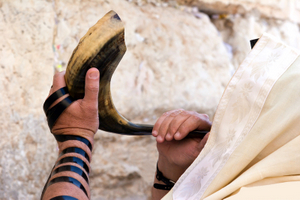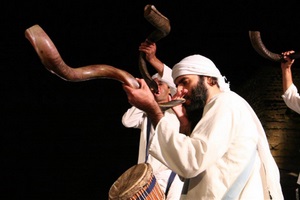יום תרועה
The moed of Yom Teruah is known by many names. Yom Teruah literally means the Day of the Shofar Sound. In Christian nomenclature it is called The Feast of Trumpets. It occurs six cycles of the new moon (i.e. six months) after Pesach on the first day of the seventh month in the Biblical calendar.
It marks the end of a long, hot, and dry summer and the beginning of the fall festivals.
As we examine this moed and discover what Scripture has to tell us about it, we should consider that the same very same G-d Who granted grace and mercy by sending His Son to die for our sins will send that same Son again to defeat His enemies and judge the world.
What does Scripture tell us about this festival and what commandments are given regarding it? What are we to do and when are we to do it?
We pray once more in the words of King David: oh, Lord, please "open our eyes that we might behold wonderful things from your Torah" and see our returning Messiah in this moed. Scripture was given to mankind to speak of Him and we should listen and hear its voice... His voice... especially during His appointed times.
What Scripture Says About Yom Teruah
Yom Teruah [יום תרועה, Strong's #3117 + Strong's #8643] means "day [of the] shout".
"Speak to the sons of Israel, saying, 'In the seventh month on the first of the month you shall have a rest, a reminder by blowing [teruah] of trumpets, a holy convocation. You shall not do any laborious work, but you shall present an offering by fire to the LORD.'" (Leviticus 23:24-25)
Although translated as "trumpet", teruah is not an actual "trumpet" as Westerns know it. Rather, it is a type of sound made with a ram's horn: a shofar.
A shofar is a ram's horn that is hollowed out and used as a musical instrument. It is "played" by blowing and vibrating pursed lips much like a modern brass instrument like a trumpet or trombone. The horn shown at the top of the page is made from a ram's horn and long, thin shofar (above right) is made from the horn of a kudu.
The NASB adds the words "of trumpets" in this passage. Teruah is used in Scripture to describe both the sounding of a shofar as well as people shouting (e.g. the "great shout" mentioned in Joshua 6:5 is the Hebrew word teruah).
The Septuagint translates the word teruah into Greek as σαλπιγγων (salpiggon, Strong's #4536) "trumpets". This word is used only 11 times in the Apostolic Writings. We'll examine these a bit more later.
Who: The sons of Israel. (Leviticus 23:24)
What:
Special commands
- It is a day of rest [Heb: sabbaton] (Leviticus 23:24)
- It is a reminder by "blowing of trumpets" (Leviticus 23:24)
- It is a day for a holy convocation (Leviticus 23:24)
- You shall not do any "laborious work" [Heb: מלאכת עבדה (melachot avodah)] (Leviticus 23:25)
- You shall present an "offering by fire" [Heb: אשּׁה (isheh)] to the LORD (Leviticus 23:25)
The Sound of the Shofar
There are traditionally three types of sounds made with the shofar (a ram's horn shofar is shown at right):
- The tekiah (the "blast") is a single long note:
- The shevarim ("broken") is a series of three rising notes:
- The teruah (the "alarm") is a rapid series of nine or more very short notes:
Since it is not known with certainty which of these three types of sounds is actually the teruah commanded by G-d for this moed, all three are traditionally sounded in a series in order to "cover all the bases".
Offerings
The book of Numbers provides the list of offerings required for this moed.
'Now in the seventh month, on the first day of the month, you shall also have a holy convocation; you shall do no laborious work. It will be to you a day for blowing trumpets. You shall offer a burnt offering as a soothing aroma to the LORD: one bull, one ram, and seven male lambs one year old without defect; also their grain offering, fine flour mixed with oil: three-tenths of an ephah for the bull, two-tenths for the ram, and one-tenth for each of the seven lambs. Offer one male goat for a sin offering, to make atonement for you, besides the burnt offering of the new moon and its grain offering, and the continual burnt offering and its grain offering, and their drink offerings, according to their ordinance, for a soothing aroma, an offering by fire to the LORD. (Numbers 29:1-6)
- The olah [burnt offering] for Yom Teruah:
- One bull (+ 3/10 ephah fine flour mixed with oil + 1/2 hin of wine)
- One ram (+ 2/10 ephah fine flour mixed with oil + 1/3 hin of wine)
- Seven male lambs one year old without defect (+ 1/10 fine flour mixed with oil + 1/4 hin of wine for each lamb)
- One male goat for a sin offering
- The olah for the new moon (Numbers 28:11-15):
- One bull (+ 3/10 ephah fine flour mixed with oil + 1/2 hin of wine)
- One ram (+ 2/10 ephah fine flour mixed with oil + 1/3 hin of wine)
- Seven male lambs one year old without defect (+ 1/10 fine flour mixed with oil + 1/4 hin of wine for each lamb)
- The continual olah (Numbers 28:3-8):
- Two male lambs one year old without defect, one in the morning and one in the afternoon (+1/10 ephah fine flour mixed with 1/4 hin of oil + 1/4 hin of "strong drink" for each lamb)
When:
In the seventh month on the first of the month (Leviticus 23:24)
Where:
No specific mention of place is given in Scripture, although the offerings must be made in the Tabernacle (or later the Temple) according to Leviticus 17:3-9.
Other Observations
There are a number of reasons to sound the shofar aside from this festival. Two of the most common reasons given in Scripture are: the arrival of a king or the anointing of a king. For example: 2 Samuel 15:10, 1 Kings 1:34, 1 Kings 1:39, 2 Kings 9:13.
All of these mention a shofar being sounded as a person is anointed and proclaimed king. So, too, we can recognize the King who reigns over Kings, the Holy One, blessed be He when we hear the shofar being sounded on Yom Teruah.
Speaking of Yeshua, the Anointed One, let's move on and examine the festival for pictures of the Messiah...


